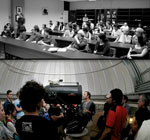2023 | 2022 | 2021 | 2020 | 2019 | 2018 | 2017 | 2016 | 2015 | 2014 | 2013 | 2012 | 2011 | 2010 | 2009 | 2008 | 2007
News 2012
Astronomers from the Université de Montréal and the CRAQ discovered an errant planet, lost in space
(2012-11-14)
Two new faculty positions for the CRAQ at the Université de Montréal
(2012-11-02)
After the Canadarm, the Canadeyes for the future Webb Telescope
(2012-07-25)
 Cutting-edge Canadian space technology directed by Université de Montréal’s René Doyon Cutting-edge Canadian space technology directed by Université de Montréal’s René Doyon |
The Observatoire Mont-Mégantic and researchers from the CRAQ witness the upcoming disintegration of a planet
(2012-07-04)
Researchers from the CRAQ discover a galaxy-packed filament using data from the Herschel Space Observatory
(2012-06-12)
A researcher from the CRAQ helps NASA open a new window on the Universe
(2012-06-11)
The Transit of Venus in front of the Sun: Clouds did not spoil the show!
(2012-06-06)
 More than 750 people on the campus of the Université de Montréal More than 750 people on the campus of the Université de Montréal |
The Transit of Venus in front of the Sun: a must-see at the Université de Montréal
(2012-05-28)
Explore wonders of the cosmos at McGill University
(2012-04-01)
This web site is for Microsoft Internet Explorer and Firefox.

 An errant planet, not orbiting any star, has been discovered with the Canada France Hawaii Telescope (CFHT) and the Very Large Telescope (VLT) of the European Southern Observatory (ESO), by a team of researchers from the Université de Montréal (UdeM) and their european colleagues.
An errant planet, not orbiting any star, has been discovered with the Canada France Hawaii Telescope (CFHT) and the Very Large Telescope (VLT) of the European Southern Observatory (ESO), by a team of researchers from the Université de Montréal (UdeM) and their european colleagues. A research team led by researchers from the MIT and NASA, including two researchers from the CRAQ (Bishop's University and Université Laval), demonstrated the upcoming disintegration of a planet around its host star. This cataclysmic event, which will happen in the next 100 millions of years, was evidenced by data from the Kepler space telescope and the telescope at the Observatoire Mont-Mégantic.
A research team led by researchers from the MIT and NASA, including two researchers from the CRAQ (Bishop's University and Université Laval), demonstrated the upcoming disintegration of a planet around its host star. This cataclysmic event, which will happen in the next 100 millions of years, was evidenced by data from the Kepler space telescope and the telescope at the Observatoire Mont-Mégantic. A team led by McGill researchers (also members of the CRAQ) has discovered, using the Herschel Space Observatory, a giant, galaxy-packed filament ablaze with billions of new stars. The filament connects two clusters of galaxies that, along with a third cluster, will smash together and give rise to one of the largest galaxy superclusters in the universe.
A team led by McGill researchers (also members of the CRAQ) has discovered, using the Herschel Space Observatory, a giant, galaxy-packed filament ablaze with billions of new stars. The filament connects two clusters of galaxies that, along with a third cluster, will smash together and give rise to one of the largest galaxy superclusters in the universe. NASA is making final preparations to launch its Nuclear Spectroscopic Telescope Array, NuSTAR. The mission, which will use X-ray vision to hunt for buried black holes, ultra-dense neutron stars, and supernova remnants, is scheduled to launch no earlier than June 13. Prof. Victoria Kaspi, from McGill and the CRAQ, leads to galactic science team to ensure NuSTAR telescope points to the most exotic objects in the Milky Way.
NASA is making final preparations to launch its Nuclear Spectroscopic Telescope Array, NuSTAR. The mission, which will use X-ray vision to hunt for buried black holes, ultra-dense neutron stars, and supernova remnants, is scheduled to launch no earlier than June 13. Prof. Victoria Kaspi, from McGill and the CRAQ, leads to galactic science team to ensure NuSTAR telescope points to the most exotic objects in the Milky Way. The Centre de Recherche en Astrophysique du Québec (CRAQ), the Université de Montréal, McGill University, the Montreal planetarium, Espace pour la Vie, the Société d'Astronomie du Planétarium de Montréal, the Fédération des Astronomes Amateurs du Québec (FAAQ) and Rio Tinto Alcan are inviting the public to look up and observe a rare phenomenon: the transit of Venus in front of the Sun. The next transit will happen in 2117, in 105 years.
The Centre de Recherche en Astrophysique du Québec (CRAQ), the Université de Montréal, McGill University, the Montreal planetarium, Espace pour la Vie, the Société d'Astronomie du Planétarium de Montréal, the Fédération des Astronomes Amateurs du Québec (FAAQ) and Rio Tinto Alcan are inviting the public to look up and observe a rare phenomenon: the transit of Venus in front of the Sun. The next transit will happen in 2117, in 105 years. Fascinated by the night sky? Intrigued by the wonders of outer space?
A series of public outreach activities organized by the McGill Astrophysics and Cosmology Group now offers the opportunity to learn from researchers about phenomena ranging from the transit of Venus to the evolution of the universe.
Fascinated by the night sky? Intrigued by the wonders of outer space?
A series of public outreach activities organized by the McGill Astrophysics and Cosmology Group now offers the opportunity to learn from researchers about phenomena ranging from the transit of Venus to the evolution of the universe.